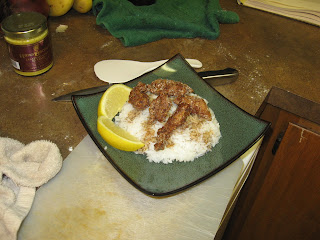On one visit our friend recommended that we try karaage, or Kara-age which he described as fried chicken. Usually I am not a fan of fried chicken (mostly dealing with my dislike for eating any meat that is on the bone) but since karaage is made from boneless chicken thighs I figured it was worth giving a shot. After trying it the first time I was hooked.
Karaage is actually very simple to make if you have any experience frying foods (my time as a cook at Skippers almost makes me a master fryer). You start with boneless chicken thighs and cut them in to pieces that would be considered bite size (or two or three bite size). You then marinate the chicken in soy sauce, sugar, garlic, ginger root, and sake (or white wine). After the chicken has marinated you coat it in a light starch (usually corn starch, though from what I've read peanut starch is most traditional). Avoid using all purpose flour because the heavier starch forms too thick of a crust.
Once the chicken is dusted in starch it is ready to be fried. I use a cast iron pan about half full of vegetable oil but you could use a wok, dutch oven, or electric fryer depending on what you have available. One of the beautiful things about using chicken thigh meat is that it is difficult to overcook the meat, so you can fry it until the crust is nice and crispy.
We learned to eat the chicken with a squirt of juice from a lemon wedge, though I have no idea if this would be considered traditional. For this batch I cut the chicken a little smaller than was preferred but you can adjust for your own surface area-to-mass preferences.
This YouTube video is helpful if you want to see the whole process from start to finish and you can use this recipe for measurements and ratios.







Looks good! I might suggest a different soy sauce. Real soy sauce usually begins with soy beans, however, in an effort to make it cheaper, several companies use hydrolyzed soy protein. It really depends on what flavor you prefer because I think that the real stuff tastes different. My brother prefers the other. A couple brands you might think about are Yamasa or Trader Joe's organic.
ReplyDeleteI've actually tried a few different varieties and currently have a bottle of tamari in the fridge but on rice I prefer the taste of the La Choy. I think it was just what I got use to growing up.
ReplyDelete